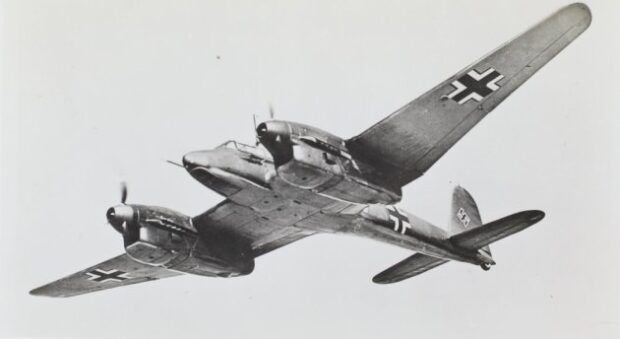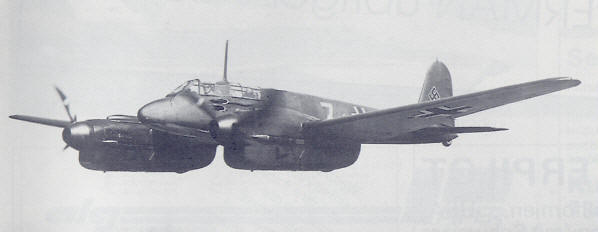The Focke-Wulf Fw 187 Falke (“Falcon”) was a German aircraft designed in 1935. It was conceived by Kurt Tank as a twin-engine, high-performance fighter, but the Luftwaffe saw no role for the design, perceiving it as intermediate between the Messerschmitt Bf 109 and Bf 110. Later prototypes were adapted to two-seats to compete with the Bf 110 in the heavy fighter (Zerstörer) role, but only nine aircraft were built in total.
Design and Development
In the early to mid-1930s, developments in airframe design outpaced available aircraft engine power. Consequently, some designs with two engines outperformed aircraft with just one engine. In European air races, the Dornier Do 17 – a military design concealed under the guise of civilian use – proved faster than single-engined fighters. Although the period of twin-engine superiority was brief, it sparked the idea in Nazi Germany of the “schnellbomber” (fast bomber), which defensive fighters could not catch. Other air forces also developed twin-engine fighters.
In 1935, Kurt Tank suggested creating a long-range single-seat fighter as a private venture within Focke-Wulf. The idea was not to produce a heavy fighter or bomber destroyer like the Bf 110, but instead a long-range fighter with the performance of a single-seat design. Powered by the new 736 kW (1,000 PS) Daimler-Benz DB 600, it had an expected speed of 560 km/h (350 mph). The design was unveiled in 1936 at an exhibition of new weapons, prototypes and projects held at the Henschel factory at Berlin-Schönefeld, where it was viewed by high-ranking Nazi officials including Hitler. However, the Reich Air Ministry (RLM) rejected the design because the single-engine Bf 109 had comparable performance at half the cost. There was thought to be little need for a long-range fighter, as it was believed bombers would not need to be escorted.
Prototypes
Tank took the design to Wolfram von Richthofen, chief of the development section of the Technischen Amt, the research and development arm of the RLM. Richthofen was not so convinced that bomber performance would remain superior to fighters, and gave the go-ahead for the construction of two prototypes on the condition that they replace the DB 600, which was in extremely short supply, with the less-powerful 515 kW (700 PS) Junkers Jumo 210. The first prototype, the V1 (D-AANA), was fitted with 680hp Junkers Jumo 210Da engines. The second prototype, V-2, was fitted with 670hp Jumo 210G engines.
R. Blaser was assigned to detail design. In order to improve performance compared with the Bf 110, the fuselage was made as small as possible. This meant there was no room on the instrument panel for the complete set of engine instruments, some of which were moved to the inside faces of the engine nacelles, as would also be done for the Henschel Hs 129 ground attack aircraft and some versions of the Bf 110. The engine nacelles were relatively normal, including both the engine and the main landing gear storage, but the front-mounted engine radiators were retractable for high speed when less frontal area was needed for the same airflow (an idea which was also used in the French Morane-Saulnier M.S.406).
The main-wheels were fully retractable and faired. Unlike some contemporary designs, like the Bf 109, the wing and tailplane required no struts. The two wing spars passed under the pilot’s seat. As was common on pre-war designs, the line of the rear fuselage flowed straight into the line of the canopy, which created less drag than a bubble canopy, but also blocked direct viewing to the rear. Cutouts in the rear fuselage and the rear section of the canopy helped compensate for this. A small window panel was fitted by the pilot’s feet to improve his view for landing.
The first prototype flew for the first time in late spring 1937, with Hans Sander at its controls. In testing it demonstrated a speed of 523 km/h (325 mph) despite the use of the low-powered Jumo engines; 80 km/h (50 mph) faster than the contemporary Jumo-powered Messerschmitt Bf 109B, despite having twice the range, more than twice the weight, and using two of the same engines. Members of the RLM complained that this was due to faulty flight instruments, but further testing ruled this out. The Fw 187’s climb rate and dive rates were also on par – if not superior – to the single-seater.
Several changes were made to the design as a result of the testing, including new DVL propellers in place of the original Junkers-Hamiltons, and experimental twin-wheel bogies that were abandoned after testing. Blaser was concerned about flutter in the rudder at high speed and had a weight fitted to reduce it but in testing this caused so much flutter it was torn off at high speed.
A second prototype followed with fixed radiators rather than earlier retractable versions, a semi-retractable tailwheel, changes to the elevator, and a vertical stabilizer with reduced chord. The engine was also upgraded to the 210G version of the Jumo, featuring direct fuel injection which resulted in a significant increase in power. New ejector-type exhaust stacks also contributed to increased speed by directing engine exhaust to the rear.
Fw 187 V2 started testing in the summer of 1937, but crashed on landing when part of the main landing gear failed, and V1 was destroyed on 14 May 1938 after a high-speed pass over the Bremen facilities when the pilot, Paul Bauer, pulled up too sharply at the end of the pass resulting in a stall that sent the aircraft spinning into the ground.
Sources: Wikipedia; YouTube


